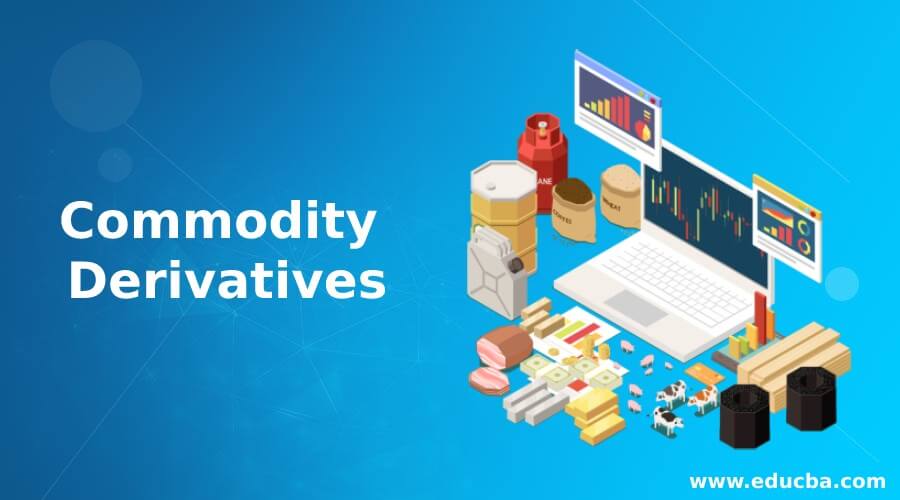Updated June 28, 2023
What are Commodity Derivatives?
The term “derivative” refers to a financial instrument whose value depends on the underlying asset’s value, such as equities, currency or commodities. A financial instrument is known as a “commodity derivative” when the contract’s underlying asset is a commodity. In a commodity market, the primary economic sector products trade instead of manufactured products. The list of underlying commodities includes metals, gas, agricultural products, oil, minerals, freight rates, emissions trading credits, weather, etc.
Explanation of Commodity Derivatives
Most of the global commodity markets primarily trade in oil, metals, and agricultural products, such as barley, wheat, maize, sugar, cocoa, coffee, cotton, milk products, etc. These commodity derivative contracts include spot prices, futures, forwards, and options. Examples of some of the other more sophisticated underlying assets include environmental instruments, interest rates, freight contracts, swaps, etc.
Examples of Commodity Derivatives
Let us look at some examples of commodity derivatives to understand how they work.
Example #1
Let us assume that a trader entered into a contract in the month of November 2020 to deliver 100 tons of steel at $500/ton in the month of January 2021. Here, the trader assures that he has a buyer at an acceptable price, while the buyer can plan in advance as he knows the raw material cost in advance with certainty. Determine the profit or loss made by the buyer in the month of January 2021
- the spot price of steel goes up to $525/ton
- the spot price of steel becomes $450/ton
If the spot price of steel goes up to $525/ton, then the buyer will make a profit of $2,500 [= 100 tons * ($525 – $500)/ton].On the other hand, if the spot price of steel becomes $450/ton, the buyer will incur a loss of $5,000 [= 100 tons * ($450 – $500)/ton].
Example #2
Let us assume that a farmer, in September 2020, entered into a futures contract with a miller to sell 10,000 bushels of wheat at $4.50/bushel in December 2020. On the day of the contract’s expiration, the wheat market price fell to $4.45/bushel. However, the miller must purchase 10,000 bushels at $4.50/bushel, higher than the current market price of $4.45. Effectively, the miller will pay $500 more [= 10,000 bushels * ($4.50 – $4.45)/bushel], while the farmer will benefit from the transaction as he will recoup a higher-than-market price.
Types of Commodity Derivatives
The commodity derivative products can be classified into four major types:
- Commodity Future: It is an agreement to either buy or sell a particular amount of a commodity on a pre-decided date at a pre-determined price.
- Commodity Forward is an agreement between two parties who agree to exchange a certain quantity of a commodity at a pre-determined price on a fixed future date.
- Commodity Option: This type of contract gives the holder the right but not the obligation to execute the transaction on the expiration date. The put option gives the right to sell, while the call option gives the right to buy.
- Commodity Swap: In this type of agreement, the floating price of an underlying asset is traded for a fixed price over a particular period of time.
Functions of Commodity Derivatives
In a commodity derivative, if the price of the underlying commodity goes up, the buyer of the contract benefits as he/she can get the commodity at a lower-than-market price and can sell in the market at a higher price. On the other hand, if the price goes down, then the seller of the contract benefits. He/ she can purchase the commodity at a lower price in the market and sell it to the contract buyer at a higher-than-market price.
What are Commodity Derivatives Used For?
The prices of commodities fluctuate over time, and adverse movement in the price results in future business risk. Thus, traders use commodity derivatives in the future or options contracts to hedge the price risk. On the other hand, some investors enter the commodity derivative market to earn possible returns depending on speculations. Many investors, who participate in the commodity derivative market, don’t hold any physical commodities because traders can invest in non-financial assets without actual possession. These investors primarily predict commodity value fluctuations based on market demand and supply.
Advantages
Some of the major advantages of commodity derivatives are as follows:
- The prices of commodities increase even during times of inflation owing to the growing demand. Hence, investors prefer investing in commodity derivatives to safeguard their capital from the adverse impact of inflation.
- Investment in commodity derivatives can help stem an investment portfolio’s losses in an adverse geopolitical event.
- Trading of commodity derivatives is done on an electronic platform accessible to all market participants, facilitating the discovery of a fair price.
Disadvantages
Some of the major disadvantages of commodity derivatives are as follows:
- Given that a large number of commodity derivative transactions are leveraged, even a small change in the price can have a colossal impact on the portfolio gains.
- The prices of commodities are largely dependent on their market demand and supply, which results in high volatility. Hence, the price movement of the commodities requires extensive monitoring.
- Investment in commodities may not be ideal for portfolio diversification as they exhibit a negative or low correlation with the prices of stocks.
Conclusion
So, it can be seen that commodity derivatives can be useful for traders and investors in multiple ways. These alternative investment avenues have the potential to earn profits in the long run if the investors systematically execute the trades.
Recommended Articles
This is a guide to Commodity Derivatives. Here we also discuss the introduction and functions of commodity derivatives along with their advantages and disadvantages. You may also have a look at the following articles to learn more –




